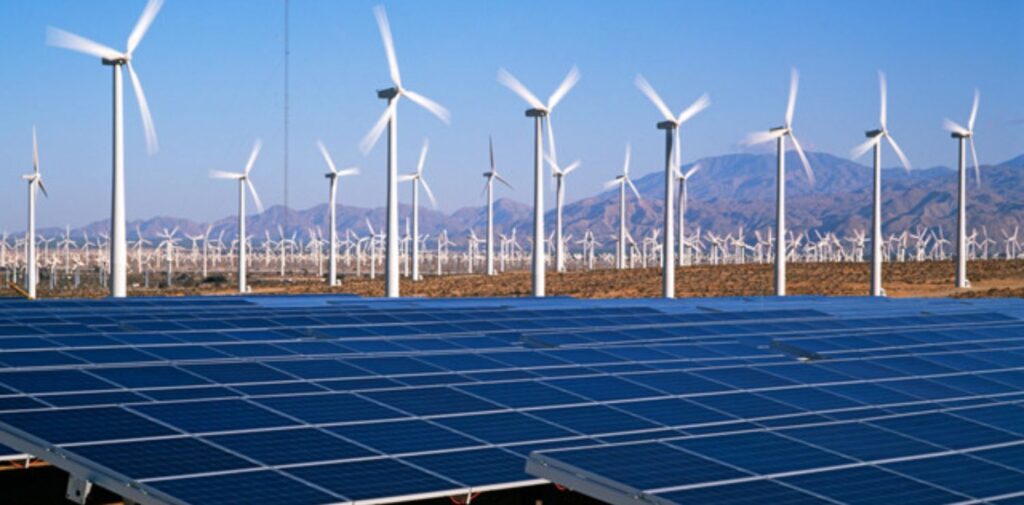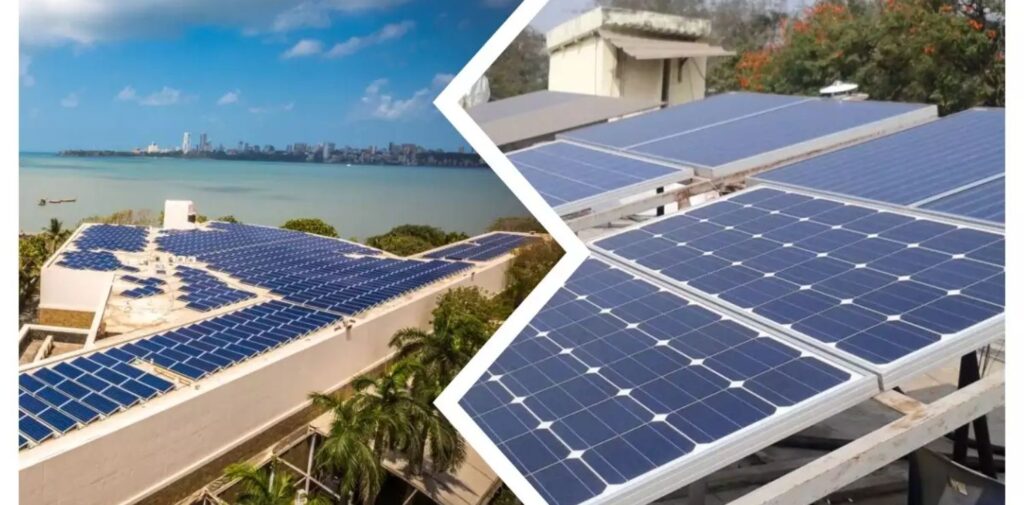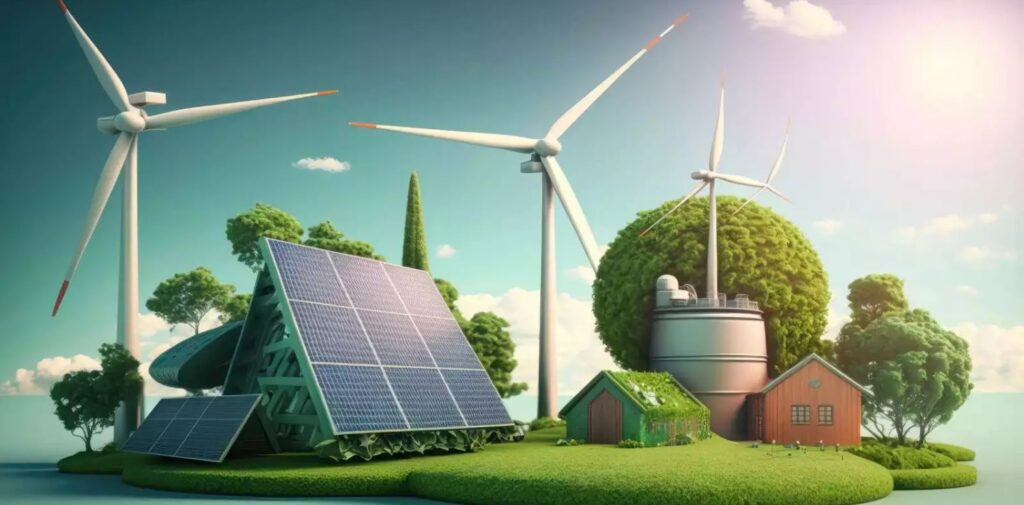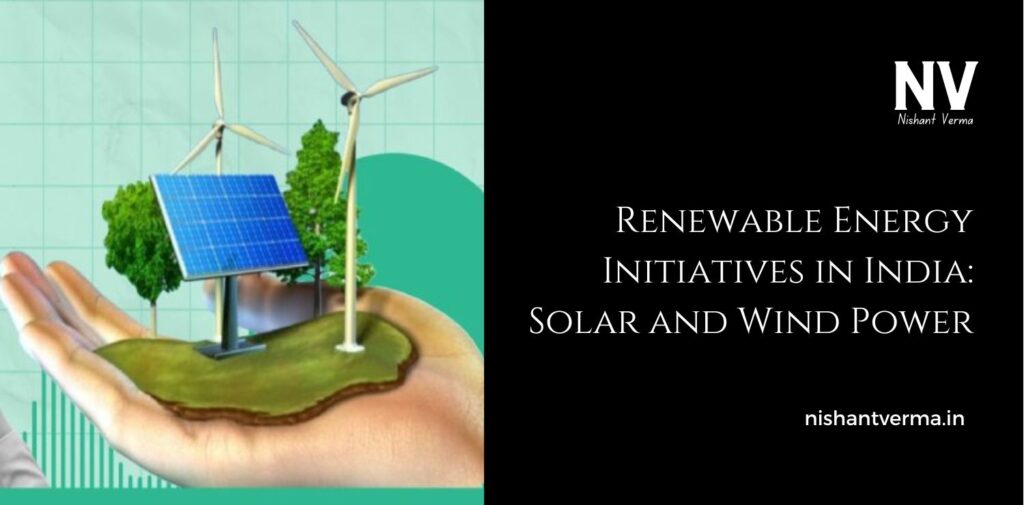In today’s world, we are becoming more and more aware of the need to protect our planet. One way we can help the environment is by using renewable energy sources instead of fossil fuels like coal, oil, and gas. Renewable energy comes from natural sources that do not run out, such as the sun, wind, water, and plants. In India, two of the most important renewable energy sources are solar energy and wind energy. Let’s explore how India is using solar and wind power to create a cleaner, greener future.

What is Renewable Energy?
Before we talk about India’s renewable energy initiatives, let’s first understand what renewable energy is. Renewable energy refers to energy that comes from sources that are naturally replenished. These sources include:
- Solar energy: Energy from the sun.
- Wind energy: Energy from the wind.
- Hydropower: Energy from water (like rivers and dams).
- Biomass: Energy from plants and waste.
These energy sources are clean and sustainable, meaning they do not pollute the air or harm the environment. Unlike coal or oil, which are harmful to the planet, renewable energy helps protect the Earth for future generations.
Why Renewable Energy is Important for India
India is a large country with a population of over 1.4 billion people. Many of these people still rely on traditional sources of energy, like coal and firewood, which are not good for the environment. These sources release harmful gases into the air, causing pollution and climate change.
By switching to renewable energy, India can reduce pollution and help fight climate change. It will also make the country less dependent on fossil fuels, which can be expensive and are limited in supply. Renewable energy, on the other hand, is abundant and free.
India has a huge potential to use renewable energy, especially solar and wind power. Let’s dive into how India is using these two powerful sources of energy.
Solar Energy in India: Harnessing the Power of the Sun
Solar energy is one of the most important sources of renewable energy in India. India is a sunny country, which means it has a lot of sunlight throughout the year. This makes solar power an excellent option for generating electricity.
India’s Solar Energy Goals
The Indian government has set a big goal to use more solar energy. In 2015, India made an ambitious plan to generate 100 gigawatts (GW) of solar power by 2022. This was a huge leap forward, and India has been working hard to meet this target. Today, India is one of the top countries in the world using solar energy.
India’s government has introduced several policies to promote solar energy. For example, the government provides subsidies or financial help to people and companies who want to install solar panels. This makes it easier for everyone to use solar power, whether it’s for their homes, schools, or businesses.
How Solar Power Works
Solar power works by using solar panels that are placed on rooftops or open land. These panels capture the sunlight and convert it into electricity using special materials called photovoltaic cells. The electricity generated can be used to power homes, factories, schools, and even entire villages.
India is building large solar power plants in the desert areas of Rajasthan and Gujarat, where the sun shines brightly for most of the year. These solar plants produce a huge amount of electricity that can be sent to cities and towns to power homes and businesses.

The Benefits of Solar Power in India
Solar energy has many benefits for India:
- It’s clean: Solar power doesn’t pollute the air or water. It’s a renewable and sustainable source of energy.
- It’s abundant: India receives a lot of sunlight, making it one of the best places in the world to use solar power.
- It helps farmers: Solar panels can be used on farms to provide electricity for irrigation systems. This can help farmers grow more crops.
- It creates jobs: The solar industry creates jobs in areas like manufacturing, installation, and maintenance of solar panels.
With the growth of solar power, India is becoming a world leader in renewable energy.
Wind Energy in India: Using the Power of the Wind
Another important renewable energy source in India is wind energy. Wind energy is produced when wind turbines (big machines with spinning blades) capture the wind’s power and convert it into electricity. India is lucky to have many areas with strong winds, especially along its coasts, making wind power a great option.
India’s Wind Energy Growth
India is ranked 4th in the world for wind energy capacity, behind only China, the United States, and Germany. In recent years, India has been rapidly expanding its wind energy sector, and the government has set a target to reach 60 GW of wind energy capacity by 2022. Wind energy has already been helping India meet its electricity needs, especially in areas where solar power is not as effective.
How Wind Power Works
Wind turbines work by capturing the energy from the wind. When the wind blows, it pushes the blades of the turbine, causing them to spin. This spinning motion generates electricity, which can then be sent to homes and businesses.
India has several wind farms along its coastlines in states like Tamil Nadu, Gujarat, and Maharashtra. These wind farms are made up of many wind turbines working together to produce a large amount of electricity.
The Benefits of Wind Power in India
Wind energy also offers many advantages for India:
- It’s clean: Like solar energy, wind energy does not produce pollution. It’s a green source of energy.
- It’s renewable: The wind is always blowing, so it’s a renewable resource that won’t run out.
- It creates jobs: The wind energy industry provides many jobs in construction, operation, and maintenance of wind turbines.
- It’s good for rural areas: Wind farms are often located in rural areas, where they can provide electricity to villages that may not have access to the grid.
India’s wind energy sector is growing fast and is helping to reduce the country’s dependence on fossil fuels.

The Challenges and the Future of Renewable Energy in India
While India is making great progress in solar and wind energy, there are still some challenges to overcome.
- Storage: Solar and wind energy depend on the weather. The sun doesn’t always shine, and the wind doesn’t always blow. This means we need better ways to store the energy for use when there is no sunlight or wind.
- Grid Infrastructure: The electricity grid in India needs to be improved to handle the large amounts of renewable energy being produced. More investment is needed in making the grid smarter and stronger.
- Investment and Funding: While the government is doing a lot to promote renewable energy, more private investment is needed to help scale up solar and wind projects.
Despite these challenges, the future of renewable energy in India looks bright. The country is committed to expanding its use of solar and wind power, and new technologies are being developed to make renewable energy even more efficient.
Conclusion: A Cleaner and Greener Future for India
Renewable energy, especially solar and wind power, is playing a huge role in India’s journey toward a cleaner and greener future. By using the power of the sun and the wind, India is not only reducing pollution and fighting climate change, but also creating jobs and improving the lives of millions of people.
As India continues to invest in renewable energy, the country will become a global leader in clean energy, setting an example for the world to follow. With more solar panels and wind turbines being built every year, the future of India’s energy is bright, sustainable, and full of hope for the planet.




